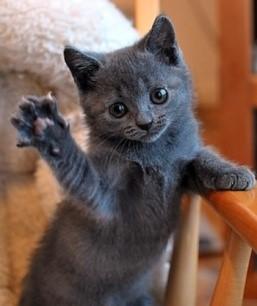
Many people ask us about declawing their cat. Their concern is for their furniture. However, do you know that declawing is considered so cruel that most of Europe outlaws it? Declawing has been illegal in England for several years. Australia, New Zealand, Germany, Wales, Finland and Brazil are among the many countries that either consider declawing illegal or inhumane, and only allow it under extreme circumstances. More and more cat related organizations, and veterinarians in the North America are mounting protests against declawing, calling it inhumane and unnecessary. While there are still some vets who will perform this operation, there are no legitimate animal protection groups that support this practice.
Dr. Nicholas Dodman, author of "The Cat Who Cried for Help," has this to say about declawing:
The inhumanity of the procedure is clearly demonstrated by the nature of cats' recovery from anesthesia following the surgery. Unlike routine recoveries, including recovery from neutering surgeries, which are fairly peaceful, declawing surgery results in cats bouncing off the walls of the recovery cage because of excruciating pain. --Declawing fits the dictionary definition of mutilation to a tee. Words such as deform, disfigure, disjoint, and dismember all apply to this surgery. Partial digital amputation is so horrible that it has been employed for torture of prisoners of war, and in veterinary medicine, the clinical procedure serves as model of severe pain for testing the efficacy of analgesic drugs. Even though analgesic drugs can be used postoperatively, they rarely are, and their effects are incomplete and transient anyway, so sooner or later the pain will emerge."
Declawing is amputation, pure and simple. To remove the claw, whether it is via traditional operation or via laser, you are removing the cat’s toes by the knuckle. Cats walk on their toes so when you remove that part of their foot, you are causing extensive pain and hardship. It could be equated to having the ball and heel of your foot cut off and making you walk barefoot.
If your cat is an outdoor cat, you should never declaw your cat. You will be leaving him defenseless against predators. He will be unable to fight off an attack or climb a tree to escape. He will be unable to climb out of a hole or ditch if he falls in.


Cats scratch for three main reasons:
A cat will select a surface where he can hook his claws, then pull against the resistance. This both strengthens the muscles and provides elasticity to muscles and joints.
Scent glands located on the cats' feet mark the area as "his”. You'll notice this behavior frequently with indoor-outdoor cats that mark trees by scratching.
You may notice a marked increase in scratching behavior when a cat is annoyed or upset.
Aside from the initial pain, other short-term effects of declawing can also lead to long-term problems, both physiological and behavioral.
A declawed cat's toe stubs will be severely painful for days or weeks after the surgery, and "phantom limb pain" may be a lifelong legacy. Some litter box granules are very painful to the cat's tender paws, and she may avoid the litter box entirely because of the association with pain. Owners can help by using a softer litter type such as one of the paper-based litters.
A cat's claws are his primary defense against other cats, dogs, or humans who would harm him. Lacking his claws, he may turn to biting, either in defense, or as a "warning" to humans who can't read his "body language." Other cats may choose "flight" instead of "fight," and become withdrawn and depressed.
Cats are "digitigrade," which means they walk on their toes. Pain in the toes can cause changes to their normal step, which eventually can cause stiffness and pain in their legs, hips, and spine. Anyone who has ever experienced prolonged foot pain will understand exactly what I'm describing.

Many cat owners who have had cats declawed in the past now say they would never consider it again, knowing what they now know, and remembering the aftermath of the surgery. Happily, there are other alternatives, so they need never subject their cats to such pain:
Cats cannot do the serious damage to furniture, drapery and rugs, with blunt nails. Trimming is a simple procedure, and if you wait until your cat is sleepy and quiet, and take it one nail at a time, over a period of several days, your cat will soon find out it's not to be feared. Simply lightly squeeze the cat's toe to extend the nail tip, and snip the tip. You can buy inexpensive clippers for this purpose at any pet store. Be careful not to cut into the dark part on the underside of the tip-- this will cause bleeding. If you're hesitant about doing this yourself, ask your veterinarian or groomer to show you how. It's a lot less expensive than declawing, and a lot easier on the cat and your conscience.

Soft Paws (www.softpaws.com) were developed by a veterinarian, and are vinyl nail caps which glue right over a cat's claws. They come in clear or colours (for the trendier cat) and also are easy to locate if one should come off. The caps grow out with the natural growth of your cat’s nails, and are said to last four to six weeks.
Feliway is a "friendly pheromone" which mimics the scent of cats' facial glands. It has been found to be useful in combating cats' urine marking tendencies, as it is thought that cats will not mark with urine where they have previously marked with facial glands. Although the original Feliway is not marketed for this purpose, some behaviorists believe it may be useful to curb undesirable scratching. There is now a specific Feliway product for scratching that you can put on scratchers to attract cats to scratch there.
If your cat is scratching your couch, try spraying the couch with the diluted juice of a lemon or orange. Cats hate those scents and will usually stay away.
Covering the area of undesirable scratching with aluminum foil or double-sided tape is a great deterrent. These surfaces don't have a texture that feels good to scratch.
It is best to use the above techniques early with your cat either when they are kittens or when you first bring them home from the shelter. Never use physical punishment as they will not associate it with a wrong act and will not only cause them unnecessary pain but it will break your bond with your cat and she will fear you. If the situation becomes dire, call a behavioural specialist or your vet as there may be an underlining issue you may not be aware of.
If your cat is scratching the arm of a couch or side of a chair, put a large towel over it. It usually stops them from scratching that area.